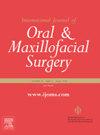下颌阻生第三磨牙手术难度分类的深度学习算法的开发与验证。
IF 2.2
3区 医学
Q2 DENTISTRY, ORAL SURGERY & MEDICINE
International journal of oral and maxillofacial surgery
Pub Date : 2024-12-04
DOI:10.1016/j.ijom.2024.11.008
引用次数: 0
摘要
本研究的目的是开发并验证卷积神经网络(CNN)算法在全景x线片上检测下颌阻生第三磨牙,并对手术拔牙难度进行分类。收集了1730张全景射线照片的数据集;1300张图片分配给训练,430张用于测试。使用混淆矩阵对模型的多类分类性能进行评价,并将实际得分与两位人类专家的得分进行比较。在手术难度指数各变量中,YOLOv5模型的精确召回率曲线下面积为72% ~ 89%。接受者工作特征曲线下面积显示YOLOv5模型将第三磨牙划分为三个手术难度等级(微平均AUC 87%)的结果令人满意。此外,该算法的得分与人类专家的得分一致。综上所述,YOLOv5模型具有准确检测和分类下颌第三磨牙位置的潜力,在x线图像中的各项指标均具有较高的性能。所提出的模型可以帮助提高临床医生的表现,并可以整合到筛选系统中。本文章由计算机程序翻译,如有差异,请以英文原文为准。
Development and validation of a deep learning algorithm for the classification of the level of surgical difficulty in impacted mandibular third molar surgery
The aim of this study was to develop and validate a convolutional neural network (CNN) algorithm for the detection of impacted mandibular third molars in panoramic radiographs and the classification of the surgical extraction difficulty level. A dataset of 1730 panoramic radiographs was collected; 1300 images were allocated to training and 430 to testing. The performance of the model was evaluated using the confusion matrix for multiclass classification, and the actual scores were compared to those of two human experts. The area under the precision–recall curve of the YOLOv5 model ranged from 72% to 89% across the variables in the surgical difficulty index. The area under the receiver operating characteristic curve showed promising results of the YOLOv5 model for classifying third molars into three surgical difficulty levels (micro-average AUC 87%). Furthermore, the algorithm scores demonstrated good agreement with the human experts. In conclusion, the YOLOv5 model has the potential to accurately detect and classify the position of mandibular third molars, with high performance for every criterion in radiographic images. The proposed model could serve as an aid in improving clinician performance and could be integrated into a screening system.
求助全文
通过发布文献求助,成功后即可免费获取论文全文。
去求助
来源期刊
CiteScore
5.10
自引率
4.20%
发文量
318
审稿时长
78 days
期刊介绍:
The International Journal of Oral & Maxillofacial Surgery is one of the leading journals in oral and maxillofacial surgery in the world. The Journal publishes papers of the highest scientific merit and widest possible scope on work in oral and maxillofacial surgery and supporting specialties.
The Journal is divided into sections, ensuring every aspect of oral and maxillofacial surgery is covered fully through a range of invited review articles, leading clinical and research articles, technical notes, abstracts, case reports and others. The sections include:
• Congenital and craniofacial deformities
• Orthognathic Surgery/Aesthetic facial surgery
• Trauma
• TMJ disorders
• Head and neck oncology
• Reconstructive surgery
• Implantology/Dentoalveolar surgery
• Clinical Pathology
• Oral Medicine
• Research and emerging technologies.

 求助内容:
求助内容: 应助结果提醒方式:
应助结果提醒方式:


